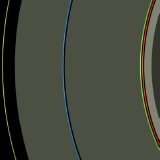 Galileo image of Adrastea. |
|
| ADRASTEA - MOON OF JUPITER | |
| Adrastea (or Adrasteia) was a nymph. She was the daughter of Ananke and Zeus and famed for punishing human injustice. Adrastea was discovered in 1979. It was found by David Jewitt in Voyager images. | |
 Voyager Discovery image of Adrastea. |
|
| Orbit | |
| Adrastea orbits close to Jupiter. Travelling at an average velocity of 31.45 kilometres per second, it completes one orbit of Jupiter in just over 7 hours. | |
| At a distance from Jupiter of 129,000 kilometres, it is not much further out than Metis. The orbits of Adrastea and Metis will eventually decay and they will collide with Jupiter. Both Adrastea and Metis are small enough not to be tidally disrupted like some of Jupiter's larger satellites. | |
 The orbits of Jupiter's inner moons. |
|
| Physical properties | |
| Adrastea is one of the smallest moons in the Solar System. It is oddly shaped, measuring 23 x 20 x 15 kilometres. It was imaged by the Galileo spacecraft in 1996/7 but remains no more than a fuzzy blob of light. | |
| Interior | |
| There is no information concerning the interior of Adrastea. | |
| Magnetic field | |
| No magnetic field has been detected. | |
| Atmosphere | |
| No atmosphere has been detected, and it is highly unlikely Adrastea could possess one. | |
| Surface | |
| No surface detail can be seen. | |
| Adrastea and Jupiter's rings | |
| The orbit of Adrastea is within the radius of Jupiter's main ring. Dust thrown off Adrastea as a result of meteoritic impact is likely to be the origin of the ring system. | |
 Map of Jupiter's ring system and inner moons. |
|
|
|
|